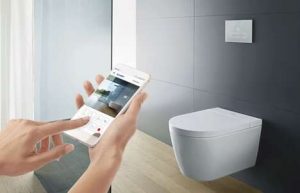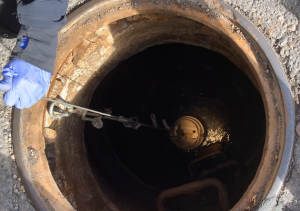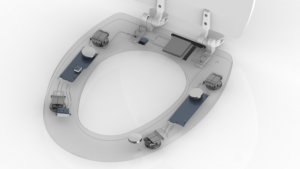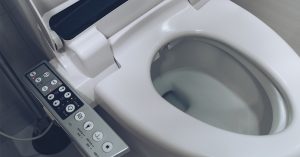I used to think washrooms were pretty clever: devices in there could track the dispensing of paper towels. They could flush the toilet by themselves. The water faucet would turn on simply in response to a wave of my hand!
But restrooms and toilet facilities are even smarter now, as the Internet of Things and artificially intelligent technologies have extended their reach into the privy. In fact, entire wastewater systems are now seen as sources of valuable health data and socio-economic information.
Smart restrooms can and will do much more than track paper and towel usage; they will check, track and report on vital life signs and signals from the user. Blood pressure, heart rate and human waste are among the sources that can be analyzed using embedded sensors and artificial intelligence programs.
Like a kind of early warning system for wellness, the information gathered from the restroom can be incredibly useful to medical officials—used in conjunction with clinical test results—when anticipating or predicting public health challenges such as epidemics and pandemics.
At the Consumer Electronic Show (CES) this year, for example, a company known as the world’s largest plumbing manufacturer introduced its new Wellness Toilet.

TOTO says its smart toilet uses multiple sensors and sensing technologies to track and analyze a consumer’s physical and mental status.
Headquartered in Japan, TOTO says its smart toilet uses multiple sensors and sensing technologies to track and analyze the consumer’s physical and mental status. Each time the individual sits on the Wellness Toilet, the company describes, it scans their body and its key outputs, then provides recommendations to improve their wellness. People can check their wellness every time they take a bathroom break, and receive wellness-improvement recommendations on a dashboard in an app on their smartphones.
Smart restroom devices like the Wellness Toilet are seen as powerful analytic, even diagnostic, tools because they have unique touchpoints to access the customer – human skin and human waste. We’re familiar with how wearable technology uses skin contact and body proximity to provide us with health and wellness information – the toilet (seat) not only uses skin contact for data collection, it analyzes the waste we leave behind (fecal matter carries a wealth of information, as anyone who has taken a FIT or stool test will know).
Yes, it is true – when we go to the bathroom, valuable information goes down the toilet. But practitioners in the new field of wastewater epidemiology have the technology to retrieve it, and they are doing so in Calgary, among many other municipalities.
Wastewater surveillance techniques and technologies are being utilized by researchers at the University of Calgary as part of testing for COVID-19 in that city.

Wastewater surveillance techniques and technologies are being utilized by researchers at the University of Calgary as part of testing for COVID-19.
Almost as easy as lowering a box into a manhole, wastewater and sewage samples can be retrieved, then chemically analyzed.
Because the COVID-causing SARS COV-2 virus leaves an identifying genetic fingerprint in waste particulates, uncovering evidence of its presence can give health care officials a broad reading on contagion levels and an outbreak in a certain area. Testing can be city-wide, neighbourhood-specific, eventually even building-centric (such as a hospital or long-term care facility), but it does not identify individual cases or contagion carriers. It does not discriminate between residents, visitors and shift workers in a catchment area. And the technique is generally recommended as a supplement, not an alternative, to case specific techniques such as PCR or RAT COVID tests.
But wastewater surveillance techniques can also monitor for other diseases, like measles or polio, or widespread opioid use.
Even before hitting the water, as it were, other vital signs from healthy (or un-) humans can be tracked using the Heart Seat, a new cloud-connected toilet seat that can track a user’s blood pressure, blood oxygen levels and other heart data.

Sensors embedded into a toilet seat collect and measure heart health metrics; collected data are transmitted to a cloud-based network using built-in WiFi and LTE.
Developed at the Rochester Institute of Technology, this cardiovascular monitoring system measures several clinical-grade metrics; analysis of the Heart Seat’s reports can enable both clinicians and patients to better manage chronic disease and reduce unnecessary hospitalizations.
It contains electrocardiogram (ECG), ballistocardiogram (BCG) and photoplethysmogram (PPG) sensors to collect and measure health metrics and electrical signals generated by heart activity; collected data are transmitted from the seat to a cloud-based network using built-in WiFi and LTE. The battery power source is said to last “several years without recharging”.
The manufacturer of the health-monitoring smart toilet seat, Casana, (formerly Heart Health Intelligence at the RIT and the University of Rochester Medical Center) has raised more than $15 million USD recently for continued development of the Heart Seat.
As health care practitioners, epidemiologists and other hygiene experts tout the value of smart

As health care experts tout the value of smart toilets, privacy experts are looking to place limits on the type of personal data advanced toilets can gather.
toilets and washroom technologies, privacy and security experts are looking to place limits on the type and scope of personal data and information advanced toilets and other restrooms fixtures can gather.
Reports that indicate some public restrooms in China use facial recognition technology to limit people’s use of toilet paper fuel the latter’s concerns. Although apparently put on pause now, the initial roll-out of facial recognition toilets raised fears that penalties or privacy violations over too much toilet paper usage were, well, too much.
Closer to home, development of a smart toilet that could monitor and assess a user’s sleep patterns and exercise habits (not to mention their medication, alcohol and caffeine intake) was also put on pause at the University of Wisconsin-Madison when developers de scribed its ability to wirelessly transfer such information to a doctor or health care provider. Concerns that unethical hackers would target such transmissions raised alarm bells.
scribed its ability to wirelessly transfer such information to a doctor or health care provider. Concerns that unethical hackers would target such transmissions raised alarm bells.
There was a time when the toilet was seen as a miraculous device; that description was apt when the toilet was new, when waste went unflushed, un-plumbed, untreated in fact.
But over the course of its long development cycle (the toilet has a fascinating history, as related in Pipe Dreams by Chelsea Wald, and people have long sought to transform its features and functions, as she relates), today’s high-tech restroom may well be vying for that title once again.
-30-



